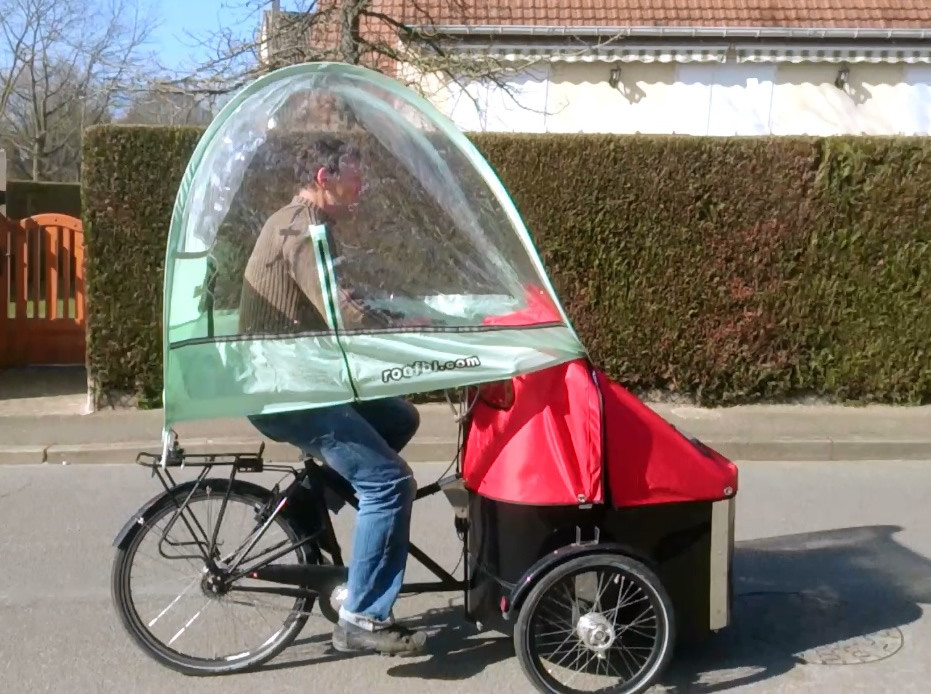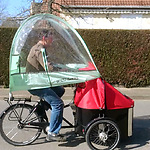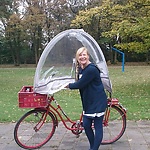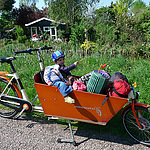New bicycle types and intelligent cycle paths can increase the share of bicycles on the island and decrease the use of private car.
The next paragraphs describe on a first level the current situation about use of bicycle in Texel, and the concepts about how new technologies could be integrated in the cycle paths in order to make them more functional and attractive.
In the Netherlands cycling is one of the prevailing means of transport, especially in the urban environment. In Texel Island, the existing cycle paths network counts for 170 km, crossing though mainly green areas. Someone can explore the island via the cycle paths, along its perimeter, also cycle to the other side, Fryslân, via the Afsluitdijk, and of course, be transported to the main land, using also the Ferry.
The use of bicycles on the island could be much more preferred, comparing to the private car. This is a direction to work on within the context of developing sustainability in the system of Texel.
A new trend that lies upon the advancement of cycling is this of the intelligent cycle paths, aiming to increase bicycles’ share in the mobility sub-system. The background idea of such an improvement is to create infrastructure that shows appreciation and respect to the cyclist and also highlight the picture of cycling as a really beneficial activity in terms of safety, personal health and comfort.
Moreover, the integration of more bicycle types, suitable for different occasions (like the Vrachtfiets) could be a way to convince people to leave their car back at home and use these bicycles.
On the one hand, for the locals, the distances travelled daily are usually short, except from the part of the population that works at the main land. In that case, people use a combination of their private car and the Ferry. On the other hand, tourists use their private car in order to carry their personal belongings and also move more comfortably around the island, or move in teams. The Vrachtfiets vehicle did not convince tourists to leave their car back. The reason for this, as we have found, is that the cyclist is not protected from the weather. What could be improved in the way that cycling is done in Texel and change people’s mind, so that they will prefer to use their bicycles rather than their private car?
The desired transition would be to achieve significant decrease in the use of private car, followed by a replacement of it with a bicycle.
Main theme
To bring this idea into a plan, we have been based on existing studies on the topic of intelligent cycle paths, such as a technical report for intelligent transport solutions for cyclists for the city of Venlo, created within the context of an internship. The presented ideas have been discussed with the writer in real time and also the potential for integrating similar ideas in Texel Island.
Technology, different types of bicycles for different occasions.
As aforementioned, the Vrachfiets is one type of bicycle that has already been introduced in Texel, not very successfully. The idea of Vrachfiets can be developed and optimized in several ways.
A point to start from is the protection and comfort of the cyclist. By this we mean, basically, the protection from the weather. The use of electricity, as a support to the cyclist, could be a good idea, also because in Texel there is the possibility for charging your car at several spots around the island, so probably the same function could apply for electric bikes. This way, people would feel confident about using the bicycle, also for longer distances. In addition to this, someone could say that the Vrachtfiets is significantly bigger than a common bicycle and therefore has lost the flexibility in use that a common bicycle provides.
If we have a look at the roofbi bicycles that aims also in protecting the cyclist from rain and wind and also provide him with storage spaces, for baggage and children, we will recognize some positive characteristics in the design that make it attractive.The cyclist still experiences transparency around him and still uses a lightweight and delicate bicycle.
Different complementary accessories have been designed for a variety of purposes: space for storing luggage only and a different one for carrying also your children. The aim is to cover the needs of the different commuters, to make cycling comfortable for as many cases as possible.
Doing some research it is obvious that attractive bicycles and accessories for all the desired purposes already exist in the market. A good idea is to check what are the suggestions of Texel market for the cyclists during our excursion, in order to point out if and what can be done differently with the aim of increasing the popularity of bicycles via the market.
Intelligent cycle paths, the bicycle as a part of the dynamic public transport system.
The first part of this chapter was focused on the bicycle vehicle. The following part though is focused on the development of the cycle paths. Both aspects are of a great importance in order to make the use of bicycle a great success in Texel Island.
Let’s see how sensor technologies, which can be integrated in the infrastructure with the function of detecting the cyclist, could contribute in an intelligent cycle path and continuously in the comfort of the users.
Adjusted luminance
A conceptual idea is to temporarily change some of the properties of the cycle path depending on presence or not of cyclists. A very good example of this would be the adjusted luminance level of the cycle path, especially at so called “dangerous locations” or along long distances that are not frequently used during night hours. The second case is very common in Texel, as the cycle path circles the island. For this purpose motion sensors can be placed in the lighting poles. The fact that when the path is empty the luminance levels are low creates potential for energy savings, while, at the same time the user still enjoys the comfort of artificial lighting at night. Similar kind of lighting can also be integrated in intersection spots, to warn the car driver that a cyclist is coming, with the aim of creating a smooth and safe flow of the traffic. Moreover, a dynamic priority concept, for the prioritization of cyclists in intersections, would also be protective for the cyclists, especially when the weather conditions are unfavorable.
Plan your bicycle trip
On a different level, apart from the safety factor, another reason why people prefer to use the car is the ability to plan their travel easier by using this means of transport. What if the cyclist could also plan his trip, by knowing the weather conditions that he will experience along a specific route and the ideal speed for his trip? Sensors such as piezo-electric sensors can be used to compute the actual speed. Transferring this into real life, the cyclist knows if he needs to go faster, or if the weather will get better and the trip will be more comfortable if started in a few minutes, how much time is needed until the destination and make choices about optimizing this time or not. Such a speed advice application could also take into account the indication of the next “greenlight”, so that the cyclist will adopt an optimum speed, not to wait at the intersections.
Real-time public transport and bicycles.
It is obvious that the advanced technologies of sensors (or thermal cameras instead, in some cases) can bring cycle paths to another level. The highest level of integration that can feasibly happen in the following years is that of real-time public transport schedule, where cycling will also be included, in-between the use of bus or any other possible public transport on the island (for example the car-sharing concept). An application that allows you to plan your trip by bicycle would be a good step for the development of cycling in Texel Island.
To picture this through a simple example, the cyclist, who knows how much time is needed to travel from his location to the closest Texelhopper bus stop (as it can be automatically computed by the “plan your bicycle trip” application), cycles until there, and catches the bus.
Moreover, taking into consideration that cycle paths are being used by locals and tourists for different purposes, different suggested routes can be drawn for the respectful commuters. In the case of tourists, paths proper for recreational purposes can be suggested, including the weather, timeline, speed, indicative frequency of use and parking areas information.



